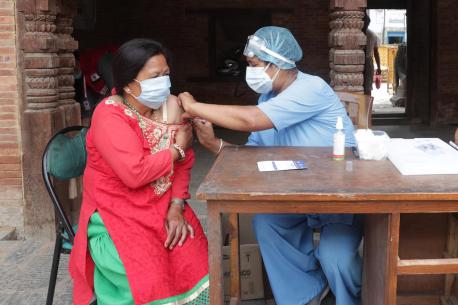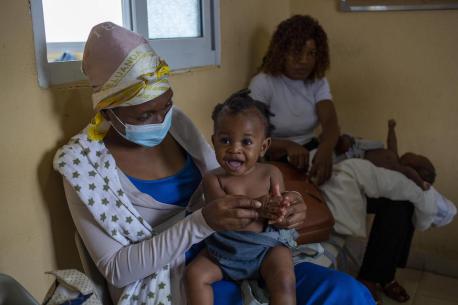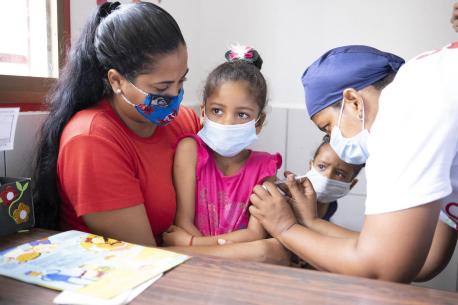
Health Workers Reflect on Nepal's Deadly Second Wave of COVID-19
Health workers on the front lines of the first and second waves of coronavirus in Nepal warn against complacency and call for more vaccines.
In May, health workers struggled valiantly to combat a second wave of coronavirus in Nepal, a second surge that was far deadlier than the first, which peaked last October. Inundated by people fleeing the surging COVID-19 virus in India, they fought to save patients from the virus, hampered by shortages of equipment, supplies and vaccines.
With the second wave subsiding, health workers reflect on their experiences and what they'll need to combat any COVID-19 waves to come.

At the Gauriphanta border crossing from India to western Nepal, UNICEF-supported volunteers help local authorities screen and register people, including many laborers. Those crossing the border receive crucial information about helplines, including a QR code they can scan with their phones to connect with protection services for women and children. © UNICEF/UN0466121
COVID-19 patients who delayed seeking treatment jeopardized their recovery
Dr. Sanjay Kumar Thakur is among the thousands of health workers in Nepal who for well over a year now have been on the front lines of Nepal’s fight against COVID-19. Thakur was a medical superintendent at the Narayani Hospital in Birgunj, in southern Nepal, before moving to his present position at Bir Hospital in Kathmandu.
Like many other medical first responders, Thakur battled COVID-19 professionally and personally. He was posted away from home when his wife and two sons all had COVID-19.
“I was so worried, but I couldn’t even go to see them,” he recalls. “Being away from them at such a time made me feel so helpless.”
Not long after he, too, survived COVID-19 during a second wave that was unexpectedly more intense than the first, with many infections more difficult to treat.
“Last year, people would come to us as soon as they had symptoms, so we were seeing a lot of mild cases,” says Thakur. “This time around, however, with so many opting to isolate at home without any contact with health workers, they would only come to us after their condition had worsened considerably.”
COVID patients came to hospitals with oxygen levels so low they risked vital organ failure, complicating their treatment.
Rachana Silwal Basnet, a health worker at Changunarayan Hospital in central Nepal’s Bhaktapur District, saw her facility, which operated as a COVID-19 referral center that directed patients to other hospitals for treatment during Nepal's first wave, expand to incorporate a 10-bed ward for patients.
“We wanted to make it easier for locals,” Basnet explains. “We didn’t want them to have to travel far for treatment and risk worsening their conditions or losing their lives in the process.”
But when cases peaked in May, beds spilled out of the ward into the hall, recalls Basnet, who worked almost nonstop with one week on 24/7 and the next week off in quarantine in the hospital.
Since Nepal's second surge began in April, UNICEF and partners have delivered lifesaving oxygen equipment, personal protective equipment (PPE) and medical supplies, including oxygen concentrators to central locations for dispatch to Karnali, Sudurpaschim, Lumbini and other provinces across the country.
UNICEF has also stepped in when hospital facilities get pushed to a breaking point. A scarcity of oxygen ventilators has been a massive concern for medical centers like Bir Hospital, where Thakur works. When Bir's ventilators stopped working and staff couldn't fix them, UNICEF helped bring in a biomedical engineer to make the repairs.
“That was a huge relief,” Thakur recalls. “We were able to bring those into use immediately for COVID-19 patients who might not have otherwise have survived.”
There is improvement in Nepal, but it isn't consistent across the nation
Despite overcrowded hospitals and equipment shortages, Nepal's COVID statistics are starting to trend in the right direction. Recorded cases and deaths have declined, with cases falling most significantly in Lumbini province.
But the positivity rate remains very high and has slightly increased in Karnali, the most remote and challenging province to access, where Nepal’s poorest and most food-insecure people live.
There are other alarming signs: At Mahakali Hospital in Nepal's southwestern province Sudurpashchim, patients with negative PCR tests whose CT scans show signs of COVID pneumonia are sounding alarms.
“We are suspecting it could be a new variant of COVID-19," Mahakali Hospital's Dr. Govinda Rokaya noted in a recent World Health Organization report, adding “similar cases are being seen in the Dhangadhi’s Seti Provincial Hospital, too.”
The virus' impact on children is also a rising concern. Like officials in India, the Nepal government fears a third or fourth wave of coronavirus infections will hit children hard. To prepare, hospitals in Nepal must now reserve 20 percent of their beds for kids.
If there is anything we can learn from the devastation that we saw in the second wave, it is that we cannot let our guard down now. — Dr. Sanjay Kumar Thakur, Bir Hospital, Kathmandu
Vaccine shortages will prolong the pandemic
The threat of new variants and the ferocity of successive waves of infection have Thakur warning against complacency.
“When cases went down after the first wave, people made the mistake of thinking everything was fine, that it was all over and we didn’t have to be careful anymore,” he says. “But if there is anything we can learn from the devastation that we saw in the second wave, it is that we cannot let our guard down now.”
Basnet agrees. Her husband, who is also a health worker, had COVID-19 and recovered without hospitalization. But she remains afraid and, like so many others, pins her hopes on COVID-19 vaccines becoming more widely available. More than 1 million vulnerable people in Nepal — primarily those over 65 — are still waiting for their second dose, a problem Basnet believes more affluent nations could solve by donating their extra vaccines.
“Vaccines are our only way out of the pandemic," says Basnet. "We need to do everything we can to secure enough doses for everyone.”

Notices posted about the shortage of COVID-19 vaccines, like this one outside a vaccination center in Mumbai, India, are commonplace across South Asia. © UNICEF/UN0457044/Bandiwadekar
Vaccines are our only way out of the pandemic. We need to do everything we can to secure enough doses for everyone. — Rachana Silwal Basnet, health worker, Bhaktapur District, Nepal
As a key partner of the COVAX Facility, a global multi-agency effort to ensure equitable access to COVID-19 vaccines, UNICEF is leading on vaccine procurement and providing on-the-ground support to prepare for and facilitate vaccine rollouts around the world.
Designed and implemented in the midst of an unprecedented public health crisis, COVAX has delivered more than 88 million doses to 131 countries and territories since February. More than 35 countries received their first COVID-19 vaccine doses thanks to COVAX.
But vaccine shortages will prolong the pandemic, giving variants more time to emerge, assuring future surges. Wealthy nations can help end this crisis by donating available vaccine doses to developing countries like Nepal now. UNICEF analysis shows that G7 countries will soon have enough doses to donate 20 percent of their vaccines between June and August — more than 150 million doses — without significant delay to current plans to vaccinate their adult populations. But countries need help preparing for and executing future vaccine rollouts, assistance that UNICEF is uniquely qualified to provide.
You can help UNICEF rush critical lifesaving supplies, services and vaccines to protect health workers and families in Nepal and surrounding countries. Please donate today.
HOW TO HELP
There are many ways to make a difference
War, famine, poverty, natural disasters — threats to the world's children keep coming. But UNICEF won't stop working to keep children healthy and safe.
UNICEF works in over 190 countries and territories — more places than any other children's organization. UNICEF has the world's largest humanitarian warehouse and, when disaster strikes, can get supplies almost anywhere within 72 hours. Constantly innovating, always advocating for a better world for children, UNICEF works to ensure that every child can grow up healthy, educated, protected and respected.
Would you like to help give all children the opportunity to reach their full potential? There are many ways to get involved.





